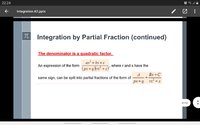burgerandcheese
Junior Member
- Joined
- Jul 2, 2018
- Messages
- 85


Hi. In the second picture (slideshow) it says the coefficients r and s have to be the same sign. But in my coursebook I don't see the authors mentioning anything about this. So do the r and s have to be the same sign or not? Or do they only have to be the same sign when performing integration by partial fractions?
Thank you in advance!
